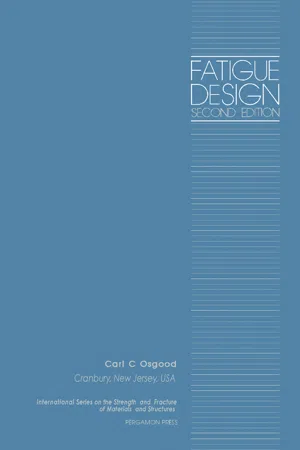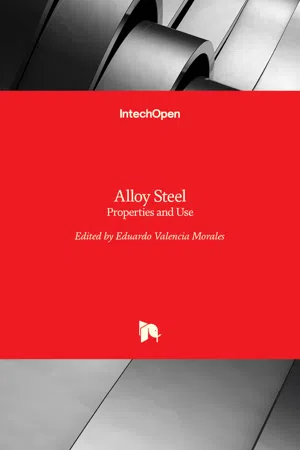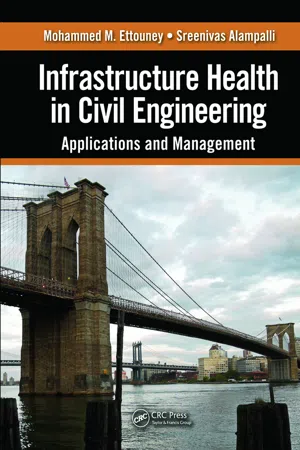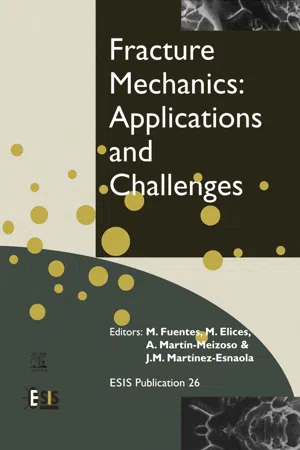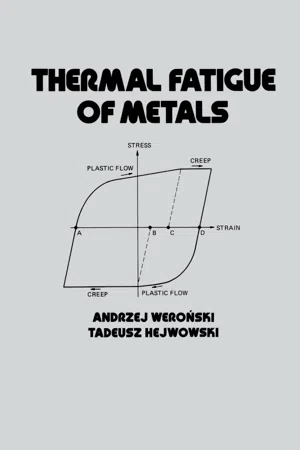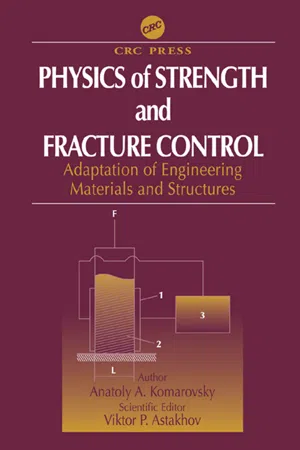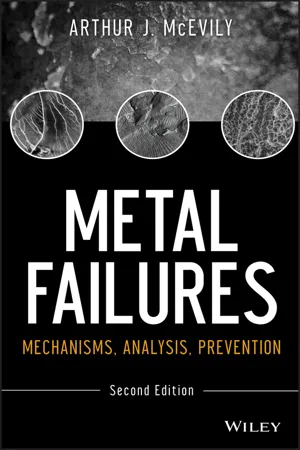Technology & Engineering
Fatigue Design
Fatigue design involves predicting and managing the failure of materials and structures under cyclic loading. It focuses on understanding how repeated stress can lead to cracks and ultimately failure, and aims to develop designs that can withstand these fatigue effects over the expected lifespan of the product. This is crucial in ensuring the safety and reliability of engineering components.
Written by Perlego with AI-assistance
Related key terms
1 of 5
10 Key excerpts on "Fatigue Design"
- eBook - PDF
Engineering Design
Papers Given at the University of Nottingham, September, 1964
- T. F. Roylance(Author)
- 2017(Publication Date)
- Pergamon(Publisher)
8 THE FATIGUE FACTOR IN ENGINEERING DESIGN E. S. BURDON SUMMARY Failure by fatigue accounts for the vast majority of service fractures and it is suggested that many of these could have been avoided by correct attention to detail design. The basic mechan-ism of fatigue is described and the dependence of allowable maximum stress ranges on com-ponent shape is emphasised in a proposed design sequence making due allowance for all factors contributing to low service fatigue strengths. Fatigue strength diagrams are given for the more usual engineering materials and a range of graphs of stress concentration factors for various engineering elements is included. INTRODUCTION To the majority of engineers the term fatigue is identified with the inexplicable failure in service of structural and machine components for which the only cure is to make the component larger. Nothing could be further from the truth ; fatigue is not an act of God but a normal engineering phenomenon which has been quite thoroughly investigated and the factors governing its occurrence are well described in the literature. Fatigue is far and away the most common reason for service failure, accounting for 80 to 90 per cent of all such fractures, and in the vast majority of cases the root cause of the fail-ure can be shown to be a defect in component shape, i.e. a design fault, rather than any deficiency in material or its heat treatment. Fatigue, the study of the behaviour of materials under repeated loading, is basic strength of materials and yet, as one authority has said, The amount of effort directed towards teaching about fatigue appears to be in inverse ratio to its over-riding importance. THE FATIGUE PROCESS The initiation of a fatigue crack, like the initiation of a static fracture, begins with the occurrence of slip inside metal crystals due to the action of the applied cyclic loads. - eBook - PDF
Fatigue Design
International Series on the Strength and Fracture of Materials and Structures
- Carl C. Osgood, D. M. R. Taplin(Authors)
- 2013(Publication Date)
- Pergamon(Publisher)
With regard to fatigue, the variations of viewpoint are as great: that the structure will exper-ience no fatigue failures during its useful life, or that safe-life cannot be predicted or a reasonably economic life goal assured. The real goals of the analytical efforts on fatigue and on damage tolerance are, of course, somewhere between these extremes, but they are so interdependent as to defy separate defini-tion and an interpretation of one certainly involves the other. The purpose of a fatigue investigation is to set a design-allowable stress such as to minimize the rate of fatigue damage in service, and to establish suitable inspection and main-tenance procedures where applicable. At present, the state of the art makes improbable the definition of a structure that will be completely free of fatigue failure for a given time under given load conditions, that is, no guaranteed safe-life. A fatigue failure is here defined as a structural failure that would require replacement of a major structural component for safety or which would have a seriously degrading effect on utility. Safe-life is the time period for opera-tion in a known environment with a known probability of exposure to ultimate loads. The distinction between safe-life and fail-safe is neither formal nor rigorous. The principal considerations in describing the concepts are: 1. The number of elements in the load path, one or more than one. 2. Parallel or series arrangement of elements along the load path. 3. Relative motion between adjacent pieces: strain or displacement. 4. Consequences of a single-element failure. 5. Monolithic or built-up forms. Figure 2.9 illustrates some of the distinctions, chiefly the influence of the number of parallel load-carrying elements. Table 2.1 continues the distinction by listing some common structures, machines, tools, devices, appliances, and so forth in a best-fit category. - eBook - PDF
- P. G. Forrest(Author)
- 2013(Publication Date)
- Pergamon(Publisher)
C H A P T E R X ENGINEERING DESIGN TO PREVENT Fatigue DesignING engineering parts to avoid fatigue failure is a more complex process than designing on the basis of static strength, because of the necessity to take account of stress concentrations and the many other factors that affect resistance to fatigue such as loads of varying amplitude and combined static and dynamic loads. The methods of procedure can be conveniently summarized under the following headings: 1. Selection of material 2. Detail design 3. Estimation of fatigue strength 4. Estimation of fatigue life. These will be considered briefly in relation to the background of fatigue information discussed in the preceding nine chapters. Selection of material For components that are subjected in service to fluctuating loads, the choice of materials should be based on fatigue strength, but in practice it is more often based on static strength, either yield stress or tensile strength. To a certain extent the choice of tensile strength is a satisfactory criterion because of the fairly close relation between tensile and fatigue strength, but it can be unreliable in some circumstances, for example, for short endurances or where fretting corrosion occurs. A comparison of fatigue strengths (determined in bending on unnotched specimens) and tensile strengths was made in Chapter III. For steels (Fig. 28), the fatigue strength increases approximately in direct proportion to the tensile strength up to a value of about 40 tons/in 2 at a tensile strength of 80 tons/in 2 and within this range the tensile strength provides a fairly reliable guide to the influence on fatigue strength of alloying additions, heat treatment and cold working. There is little further improvement in fatigue strength, however, with further increase in tensile strength. Consequently, for a part whose strength is limited by its resistance to fatigue, there may be little benefit in using a steel with a static strength above 80 tons/in 2 . - eBook - PDF
Alloy Steel
Properties and Use
- Eduardo Valencia Morales(Author)
- 2011(Publication Date)
- IntechOpen(Publisher)
The following principles are adopted in the design based on fatigue considerations: A. Safe-life design : The underlying assumption in this approach is that the service load is well known and fixed e.g. parts of rotating machinery, engine valves etc. The maximum stress in the fatigue cycle should preferably be less than the fatigue limit of the metal to ensure high fatigue life. If the metal does not exhibit a definite fatigue limit, then the allowable stress level corresponding to desirable life cycles, say 7 6 10 or 10 is chosen from S-N curve as the limiting/design value. In some cases, as specified by ASME code, the design is based on maximum shear stress theory of failure. Alternating stress intensity which is equal to twice Metal Fatigue and Basic Theoretical Models: A Review 211 the maximum shear stress or difference in principal stresses is used as a design factor in conjunction with ASME fatigue curves. B. Fail-safe design : It is employed when service load is of random nature and contains overload or underload spikes e.g. in aircrafts and ships. Since cracks are unavoidable, the fatigue crack is allowed to grow but the structure is designed in such a way that the crack does not become critical. Crack arrestors are implanted at various positions in the structure. In other words, this concept is based on introducing alternative load bearing members such that failure of one could be tolerated by load redistribution to the remaining members. Structures that don’t permit multi-piece parts can’t be designed with this principle. C. Damage tolerance : Cracks are allowed in this approach as well but stringent periodic inspections are undertaken to check whether the crack size is below the permissible or critical value. Such inspections are regularly carried out in nuclear and aviation industries. A method is available [18] that provides a rational basis for periodic inspection based on crack growth, taking into account variability of various parameters. - eBook - PDF
Infrastructure Health in Civil Engineering
Applications and Management
- Mohammed M. Ettouney, Sreenivas Alampalli(Authors)
- 2011(Publication Date)
- CRC Press(Publisher)
247 5 Fatigue 5.1 INTRODUCTION 5.1.1 G ENERAL Fatigue is the process that describes how damage accumulates as a stress/strain cycle within met-als. As the number of stress/strain cycles increase, the cumulative damage increases. Under certain conditions, the cumulative damage will lead to metal failure. The initial damage due to stress/strain cycles will occur as cracks. As the number of cycles increase, the crack will grow. Depending on the stress/strain magnitude and the type of material, the crack growth either will be arrested or will continue until the material fails. There are three modes (types) of crack formations (Barsom and Rolfe 1999): Mode I: Tearing mode where two sides of the crack pull away from each other. • Mode II: Sliding mode, where the two sides of the crack slide against each other in a sym-• metric fashion. Mode III: Shearing mode, where the two sides of the crack slide against each other in an • asymmetric fashion. Most of fatigue cracks in civil infrastructures are of type I. Factors affecting fatigue life include loading, design errors, manufacturing, construction or assembly defects, material defects, poor quality assurance (QA) or quality control (QC), residual stresses, and environmental conditions such as temperature or humidity. Another important aspect to keep in mind is that fatigue is highly uncertain. Any efforts regarding fatigue effects or mitigation measures need to account for this uncertainty to some degree. One of the important fatigue failure properties is that the threshold of the fatigue failure stresses is a function of the stress level. As the stress level is reduced, the number of cycles that can occur before failure is increased. At the limit, there is a stress value below which no failure will occur no matter how many stress cycles are applied to the material. Such a relationship is known as S-N curves. This phenomenon is known as high-cycle fatigue. - eBook - ePub
Metal Failures
Mechanisms, Analysis, Prevention
- Arthur J. McEvily, Jirapong Kasivitamnuay(Authors)
- 2013(Publication Date)
- Wiley-Interscience(Publisher)
For example, a plate of steel that contains a hole of 1 mm (0.04 in.) diameter will have a higher fatigue strength than a plate containing a hole of 1 cm (0.4 in.) diameter, despite the fact that in both cases the stress concentration factor is 3.0. Materials in engineering usage are often cyclically loaded in corrosive environments that degrade the fatigue properties. For example, ship propellers and drilling platforms operate in sea water, which accelerates both the crack initiation process and the crack growth process. The term corrosion fatigue is used to describe the combined action of cyclic loading and corrosion. A related form of fatigue is known as fretting corrosion fatigue, with fretting being due to the relative motion of surfaces under pressure—for example, between a rivet head and the clamped sheet metal in an aircraft structure. Aircraft turbine blades experience huge numbers of vibratory cycles during their lifetimes; for this reason, there is interest in fatigue at ultra-high cyclic lifetimes, such as cycles. In some of these ultra-high fatigue lifetime studies, it has been observed that for certain steels at high numbers of cycles, a drop in fatigue resistance can occur due to the growth of subsurface fatigue cracks. In assessing the fatigue performance of turbine blades, the possibility of foreign object damage (FOD) due to the ingestion of hard particles into an aircraft turbine engine must be taken into account. The effect of bird strikes on turbine blade performance is another consideration, one that, until recently, precluded the use of composite materials as first-stage turbine blades because of their low resistance to bird-impact damage. Much of the early testing in fatigue was carried out under fully reversed loading, where the mean stress was zero, as in the case of a railroad car axle. However, components are often cycled about a mean stress other than zero, and the designations and are used to describe such loading conditions - M. Fuentes, M. Elices, A. Martín-Meizoso, J.-M. Martínez-Esnaola(Authors)
- 2000(Publication Date)
- Elsevier(Publisher)
13 SOME ASPECTS OF FATIGUE OF ENGINEERING MATERIALS HAEL MUGHRABI Institut ffir Werkstoffwissenschaften, Lehrstuhl I, Universitfit Erlangen-Nfirnberg Martensstr. 5, D-91058 Erlangen, Federal Republic of Germany ABSTRACT Fatigue failures are generally the result of repeated plastic cyclic microstrains leading ultimately to the initiation and propagation of cracks. Fatigue crack initiation (and propagation) can occur in different ways and is frequently preceded by some form of cyclic strain localization. In this presentation, examples will be given of different types of fatigue studies on a number of metallic engineering (and model) materials. The aim will be to highlight different aspects of fatigue behaviour and to illustrate different experimental approaches in the study of fatigue phenomena. Some topics of current interest will be addressed, referring to recent work on the fatigue behaviours of materials of ultrafine grain size, metal-matrix composites, a cast magnesium alloy and, finally, the high-temperature fatigue of monocrystalline nickel-base superalloys. KEYWORDS Fatigue life, ultrafine grain-size materials, metal-matrix composites, cast magnesium alloys, nickel-base superalloys, elastic compliance, damage parameter, fatigue crack initiation, fatigue crack propagation, microstructure. INTRODUCTION Fatigue fracture is one of the most common types of materials failure. It occurs in materials and components subjected to repeated cyclic loads which would normally not cause damage, if applied only once monotonically. It is now well established that fatigue damage originates from (small) repeated cyclic microstrains (in the order of 10.5 to 10-2) which ultimately lead to some form of strain localization, followed by subsequent initiation and propagation of cracks in the case of ductile materials and to almost immediate propagation of cracks in the case of less ductile high-strength materials.- eBook - PDF
- Andrzej Weronski(Author)
- 1991(Publication Date)
- CRC Press(Publisher)
The elements exposed to thermal fatigue must support loads and transmit forces that may be constant or variable and in many instances are also exposed to corrosion and erosion. Hence machinery and structures subjected to elevated and varying temperatures are exposed to many mechanisms of failure, among which pure thermal fatigue may have a dominant or subsidiary, but still significant role. Methods of estimating the durability of components when mechanical fatigue, creep, and thermal fatigue occur simultaneously were discussed in Chapter 6. In the general case, other potential causes of failure will also be present, ranging from excessive stress due to unnecessary constraints on expansion to simple underdesign. Diagnosis is complex and time consuming so that failures in the field 340 Matters for Consideration in Designing 341 are frequently rectified on an ad hoc basis and only if the part repaired fails repeatedly is consideration given to the overall design. A vast amount of data from such failures still awaits scientific description and explanation. The material in this chapter, based on laboratory data and industrial experience, is intended as an aide-mémoire for the designer and user. The specific examples and case histories described will serve a more general purpose if they highlight the importance of awareness of thermal phenomena when examining any initial design concept from every aspect, with an eye alert for the unexpected contingency and the obvious flaw. The purpose of the specific examples and case histories described is to highlight the general need for awareness at the design stage of all the thermal phenomena that may be encountered when the design is put to use. - eBook - PDF
Physics of Strength and Fracture Control
Adaptation of Engineering Materials and Structures
- Anatoly A. Komarovsky, Viktor P. Astakhov(Authors)
- 2002(Publication Date)
- CRC Press(Publisher)
467 7 Fatigue: Physical Nature, Prediction, Elimination, and Relief 7.1 Introduction Cyclic loading is one of the varieties of the force field. Differential form of the thermodynamic equation of state (Section 2.4) makes it possible to derive an equation for thermodynamic fatigue (Section 7.2),. that relates the number of loading cycles (known also as cyclic fatigue life) to working parameters of the alternating force and thermal fields. It also characterizes mechanical fatigue at constant temperature and thermal fatigue in constant force fields. Comparison of theory and experiment yields good coincidence. Section 7.3 shows that the physical nature of fatigue is in the active occurrence of compresson–dilaton phase transitions (following the diagram in Figures 1.15) under thermal insufficiency at alternating deformation. This stimulates for-mation of the flow of failures of interatomic bonds at the Debye temperature. Sometimes fatigue fracture develops at the presence of x-ray radiation. Section 7.4 gives expressions for thermal-radiation, mechanical-radiation, and thermal–mechanical–radiation fatigue as well as their comparison with experiment. The relationships derived allow calculation of fatigue life and also indicate methods for fatigue relief and elimination (Section 7.5). In many respects, they are similar to those described in Section 5.8 and work effi-ciently at the reversible stage of occurrence of deformation processes. 7.2 Equation of Thermomechanical Fatigue Fatigue implies a process of gradual accumulation of damages in the initial structure of a material under the effect of dynamic variations in the parameters of one or several external fields (force, thermal, radiation, chemical, etc.). This leads to initiation of a fatigue crack and its propagation, and ends with 468 Physics of Strength and Fracture Control sudden fracture. - eBook - PDF
Metal Failures
Mechanisms, Analysis, Prevention
- Arthur J. McEvily, Jirapong Kasivitamnuay(Authors)
- 2013(Publication Date)
- Wiley-Interscience(Publisher)
240 FATIGUE III. DESIGN CONSIDERATIONS The fatigue lifetime is strongly affected by a number of factors, such as the type of loading—for example, bending, axial, multiaxial, or torsion. The presence of a notch or hole will reduce the fatigue resistance, but not simply as a direct function of the notch stress concentration factor; the size of the notch or hole is also a consideration. For example, a plate of steel that contains a hole of 1 mm (0.04 in.) diameter will have a higher fatigue strength than a plate containing a hole of 1 cm (0.4 in.) diameter, despite the fact that in both cases the stress concentration factor is 3.0. Materials in engineering usage are often cyclically loaded in corrosive environments that degrade the fatigue properties. For example, ship propellers and drilling platforms operate in sea water, which accelerates both the crack initiation process and the crack growth process. The term corrosion fatigue is used to describe the combined action of cyclic loading and corrosion. A related form of fatigue is known as fretting corrosion fatigue, with fretting being due to the relative motion of surfaces under pressure—for example, between a rivet head and the clamped sheet metal in an aircraft structure. Aircraft turbine blades experience huge numbers of vibratory cycles during their lifetimes; for this reason, there is interest in fatigue at ultra-high cyclic lifetimes, such as 10 10 cycles. In some of these ultra-high fatigue lifetime studies, it has been observed that for certain steels at high numbers of cycles, a drop in fatigue resistance can occur due to the growth of subsurface fatigue cracks. In assessing the fatigue performance of turbine blades, the possibility of foreign object damage (FOD) due to the ingestion of hard particles into an aircraft turbine engine must be taken into account.
Index pages curate the most relevant extracts from our library of academic textbooks. They’ve been created using an in-house natural language model (NLM), each adding context and meaning to key research topics.

